AMT Lab is researching emerging digital fundraising tools so that arts organizations can, hopefully, take a bigger part of the 14% increase in online giving. With $380 billion dollars of giving in the USA in 2017 and more people than ever giving online, the future of fundraising is changing before us. And don't be fooled -- the majority of the online donors were older than 49 years old. To understand how the arts can maximize current and emerging fundraising opportunities, a benchmark of what is happening in the field today is underway.
Final Three: Free Tools and New Ideas from NTC 2017 (Part III of III)
#TBT - Crowdfunding Mania
Museum Data and What To Do With It – Children’s Museum of Pittsburgh Part Two
As a part of the “Museum Data and What to Do with It” series, AMT Lab contributor Kate Lin takes a look at the Children’s Museum of Pittsburgh’s journey of adapting to technology trends, and how Big Data is changing the museum’s operations. This post focuses on the visitor experience and development at the Children’s Museum of Pittsburgh. More on how data influences the Museum's marketing efforts can be found here.
Unique Audience Structure and Visitor Experience For Children’s Museums
George Brzezinski, the Director of Visitor Services at the Children’s Museum of Pittsburgh, oversees all aspects of visitor services at the museum from admission, cafes, to rental events. Brzezinski brought his previous experience in the sports management field into the non-profit world 12 years ago. When asked about the most significant difference is in terms of visitor service at the Children’s Museum compared to other organizations, Brzezinski said, “the age of our visitors, obviously.”
Many visitors at the Children’s Museum of Pittsburgh are below the age of ten, which makes customer service especially important. To serve its audience’s needs, the museum is constantly working on enhancing visitor experience by finding ways to speed up the admission process. “When the most common visitors are young parents with small children, there’s not much room for patience at the admission desk. Data and technology changed every part of our operations, especially in terms of admissions and membership,” said Brzezinski.
Qualitative data collected through surveys and social media channels is informative in providing the museum with customer feedback. Parking fee collection is one great example of how the museum responded to customer feedback using technology. Instead of having people pay the parking fees at the admissions desk, visitors can now pay at the machines in the parking lot. This seemingly modest change has made the admissions process much quicker and more convenient for the museum members. Now members can pass through the desk quickly and start enjoying the museum without taking out their wallet and waiting for the payment to be processed. There’s also an app for people to download that remembers their car’s license plate number and credit card information, making the payment process as simple as hitting a button on their device on each visit.
Efforts and Challenges in Data Collection at the Children’s Museum of Pittsburgh
The unique composition of its audience also makes collecting data at the admissions desk a difficult task. As of now, the museum only collects zip codes from their patrons, unless they make a purchase at the museum. The target audience of the children’s museum are families with children. This audience group values efficiency and convenience more than others. If patrons purchase a membership, other data such as name, age, address and phone number can be collected. For regular visitors or non-members, it is almost impossible for the children’s museum to collect more data without sacrificing the quality of visitor experience.
However, the Children’s Museum of Pittsburgh has a department of learning and research that conducts audience surveys separately from the admissions process, attempting to make up for the information that is hard to collect at the front desk. The department utilizes special events such as birthday parties, reunions, and field trips, to gather feedback and shape profiles for different audience segments based on the results.
Data Integration: From Point-of-Sale E-Commerce Data to CRM Database
The implementation of Siriusware, an on-site ticketing and point-of-sale software, has significantly improved the data integration at the Children’s Museum of Pittsburgh. Siriusware delivers essential features required at every point-of-sale from online shopping, e-gift cards to admissions. Prior to Siriusware, the Children’s Museum of Pittsburgh had TicketMaster Vista, which did not automatically integrate e-commerce data with the museum database. Whenever a customer bought a membership online, the museum staff would have to manually enter the data into their database. With Siriusware, all point-of-sale data is integrated in real-time. An additional add-on connects Siriursware to Raisers’ Edge, the primary donor database at Children’s Museum, and allows the membership data to flow into the donor database and vice versa.
However, there are still some limitations of the current system to fit all the needs for Children’s Museum of Pittsburgh. Unlike some museums that outsource their café operations to a third-party provider, the Children’s Museum runs its own café service – the Big Red Room Café. Compared to other software packages that are designed for the food industries, Siriusware currently has limited functionality when it comes to managing food inventory.
Data Provides Insights for Development at Children’s Museum of Pittsburgh
Gina Evans, the Director of Development, oversees the museum’s development efforts to raise two million dollars to support their annual operational budget, plus another one million to support other special projects and campaigns. Evans leads a four-person team, covering areas including corporate giving, individual giving, grant writing and special events.
Donor data is stored in the Raiser’s Edge database. The team tracks and analyzes the data to support the museum’s fundraising efforts. The team pays attention to trends over time, looking at the type of giving and how people give from year to year. Raiser’s Edge helps the development team tremendously for its ability to target each specific donor group differently based on the reports that it generates.
Examining data from Siriusware and MailChimp also provides the museum additional insights to detect potential future donors. It allows the museum to track people who make donations online or at the front desk and members’ activities in the museum. Mailchimp makes it easier to track the changes of the open rates and for the museum to test the effectiveness of different targeting strategies to those potential donors.
Mobile Bidding App Streamlined Fundraising Events
The Children’s Museum of Pittsburgh was one of the first cultural organizations to use GiveSmart, a mobile bidding app for its fundraising events. The app handles the guest registration and helps with the auction and bidding process. The customers can register on site or pre-register online in advance. It is a high functional tool to collect visitor data and streamline the event process by providing real-time data reports such as which items are more attractive to the audience or which ones are neglected. The real-time reports allow the museum to take immediate actions to further promote those neglected items on-site. The data collected by the app also provides the development team with valuable insights into the audience’s preferences and bidding habits when planning for future events.
It took the museum more time to set up the mobile app, it has made it much easier to manage the auction data and financials for the fundraising events. Other Pittsburgh non-profit organizations, such as Society of Contemporary Craft, have just begun to use this app after consulting with the Children’s Museum of Pittsburgh.
Challenges to Utilize Data For Development Efforts At the Children’s Museum
Budget is always a concern in terms of acquiring other technologies or talents in helping the museum to interpret data. Aside from looking into possibilities to purchase more advanced software packages, the staff is continuously looking into maximizing the functionalities of their current resources. The development team is also looking to take more advantage of the crystal reports function, a reporting tool within Raiser’s Edge database that takes the reporting to a much more detailed level.
According to Evans, the average members of the Children’s Museum remain for about four years and leave when their children are about eight years old, moving on to other organizations such as the Science Centers or the zoo. Those members might return to the museum when they have new children or even grandchildren. One of the things that the museum is trying to achieve is to establish the donor profile over his or her life time to establish patterns of behaviors and better understand its donors. “Currently we don’t have those data profile because our museum has only been around for 36 years, which is only a generation long,” said Evans.
Like many other non-profit organizations, the Children’s Museum of Pittsburgh is challenged by not always having the ability to collect the data it needs or the capacity to digest and analyze the data it has. However, the museum has continued to demonstrate growth and a strong dedication to providing high quality content and service for its visitors. With standardizing data analysis being one focus for the upcoming 3-year strategic plan process, we will certainly look forward to the progress that the museum can achieve.
Banner Image "Lion Dance by Josh Gates" provided by Children's Museum of Pittsburgh
White Paper Wednesday: Silicon Valley Philanthropy
Five reasons Why You Should Consider Using a Mobile Bidding App For Your Next Fundraiser Auction
#TBT: A Guide to Web-Based Fundraising and Philanthropy
Web 2.0 has changed many aspects of the modern world, and fundraising and philanthropy is no exception. From the tidal wave of tech tycoons committing to the Giving Pledge to the rise of crowdfunding (and a bevy of potential platforms for a crowdfunder to choose from), soliciting essential funds has more avenues than ever--and more potential challenges along with them. This week's throwback rounds up numerous articles that provide time-tested wisdom on how to navigate in the new world of web-based fundraising and philanthropy.
Research Update: Google for Nonprofit Arts
In today’s culture, Google is seen as one of the most innovative technology companies in the world. From its search engine to the Android operating system, Google has permeated every aspect of our techno-centric lifestyles. Beyond the scope of their technological accomplishments, Google strives to help nonprofit organizations around the world by providing them with free online tools and access to grant monies. Follow the development of this research here.
Tips for Choosing a Grants Management System: Part 2
Throughout the process of selecting and implementing a grants management system (GMS), an arts organization must consider many factors in order to ensure positive results. These factors fall into four main categories: vendor interviews, data migration, integration, and training. All of equal importance, these categories must be weighed to find the optimum balance of system features and vendor characteristics.
Today we focus on the last two categories—integration and training. To read the first part of this two-part series, click here.
Tips for Choosing a Grants Management System: Part 1
Throughout the process of selecting and implementing a grants management system (GMS), an arts organization must consider many factors in order to ensure positive results. These factors fall into four main categories: vendor interviews, data migration, integration, and training. All of equal importance, these categories must be weighed to find the optimum balance of system features and vendor characteristics.
Today we focus on the first two categories—vendor interviews and data migration.
Grants Management Systems: Primer for Best Practices, Part 4
State arts agencies need to report not only to NASAA and the NEA, but also to other entities, such as state legislatures and the general public. These reports communicate impact to all stakeholders within the agency and across its jurisdiction. A GMS’s querying and reporting capabilities impact how this information is accessed and, ultimately, understood.
Grants Management Systems: Primer for Best Practices, Part 3
With grants management systems, the whole application process can be done online. To accommodate the needs of a diverse pool of reviewers, the system should allow them to view each application online and to access and download each application in a printer-friendly format. Grants managers should take full advantage of GMS panel review features by incorporating funding formulas (weight and average calculations) to the evaluation forms that reviewers fill out and then having reviewers input their final scores into the system.
Opportunities Abound: Starting a Peer-to-Peer Fundraising Campaign
Telemarketing is Dead - and I killed it
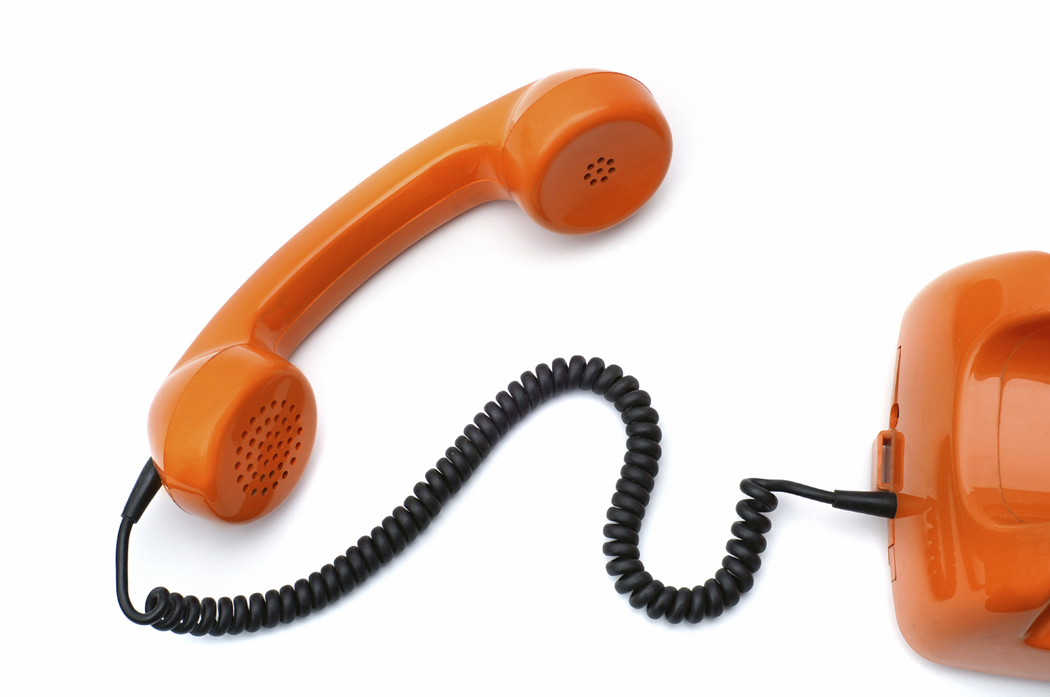 Fundraising for nonprofit organizations is considered an art, not a perfect science, and it's clear that techniques must be tailored to each individual organization. One of the common pieces of wisdom is that “telephone appeals” (read: telemarketing) consistently work as a fundraising tool for nonprofit arts organizations. I’m not saying random cold calls, but calling people who have funded you before, have a history with your organization and would likely donate again. Nearly one out of every five people will respond and donate to your organization calling and asking for money.
As a Millennial consumer, I cannot fathom this.
Fundraising for nonprofit organizations is considered an art, not a perfect science, and it's clear that techniques must be tailored to each individual organization. One of the common pieces of wisdom is that “telephone appeals” (read: telemarketing) consistently work as a fundraising tool for nonprofit arts organizations. I’m not saying random cold calls, but calling people who have funded you before, have a history with your organization and would likely donate again. Nearly one out of every five people will respond and donate to your organization calling and asking for money.
As a Millennial consumer, I cannot fathom this.
I, and perhaps you, dear Reader, belong to a generation simply called “Millennials”. Spell check doesn’t know that word yet, but soon it will. We are defined not by high technological competency, which is given to the generation directly before us, but by technological connectedness. I've had a series of experiences which have lead me to create these conclusions about the relationship between Millennials and telemarketing. Millennials, who by the way love to donate, have been raised in a society where everything is connected electronically.
With that connectedness comes with a degree of anonymity. While relationships formed over the web can become as close and as intimate as the penpals of old, they take time. They are cultivated with mutual respect and friendship and while our messages may travel instantly from one to the other, the relationship is built up more slowly.
In this age of instant communication, I think the telemarketing approach is dead to those arts organizations that wish to solicit donations from Millennials. My telephone is reserved for my parents and my grandma, and for calling Renee to let her know I’m outside her building and would she please let me in.
I have had organizations, which I have supported in the past, call me on the phone and ask for donations. It never works.
They always follow a certain pattern. The telemarketer introduces themselves, and asks your name - here again, trying to build up a relationship. But I, the Millennial consumer, am used to long exchanges on Tumblr before ever learning anything than the other person’s username, so that tactic falls short. I thrive in the anonymity of the internet, and this direct and sudden confrontation with a stranger frightens me like a deer in headlights.
Then the telemarketer will try to tell me about the organizations hardships this year; how an economic recession has set them back, or how government legislation has made their work more difficult, could I please help with their annual fund? I, the Millennial consumer, just watched a video of the violence in Syria this morning - you’re trying to tell me you have problems? The problems I care about are the ones involving life and death - and I will negate your ask at every turn.
Finally, the telemarketer has been instructed to ask three times before respectfully hanging up. Are you kidding me? I, the Millennial consumer, tweet, reblog, and share on Facebook all while drinking my caramel latte and finishing an accounting assignment. Your long phone call is wasting my time. Why didn’t you understand when I first said ‘no’? Are you trying to guilt me into this? This is ridiculous. I will never give to this organization again, and their number is now blocked on my phone.
In truth, this all could have been avoided if this organization, who clearly have a record on me, had just emailed me their ask with a direct link, explaining that they need help with their annual fund. The anonymity is intact, I no longer have an individual I don’t know trying to force me into the intimate donor relationship. They haven’t insulted me with blowing their issues into hyperboles (while important to the organization, meaningless to me). And it took all of two seconds to click the link and another to type in my credit card number.
What I’m saying here is, if you’re catering to a mature audience, use telemarketing. Statistically, it works. And probably you’re already using online direct asks in some form, whether its email or otherwise. What I’m hoping you’ll do is pay more attention to who gets what message. If you’re reaching for the Millennials, those fun-loving young kids, maybe tweet them. Email them. Ask them when they attend your next party.
For the love of art, though, do not call.
Mobile Fundraising Applications: The Apple policy over one year later
 Apple banned fundraising apps for the iPhone, iPad, and iPod over a year ago (to much controversy) just as the first fundraising app hit the market through eBay/MissionFish. The field of software for fundraising as a result of the ban is anemic.
Until this policy is removed it seems unlikely that major fundraising will take place via mobile applications. As the iPhone is the number one smart phone on the market developers have much less incentive to build software for fundraising purposes. It can be extrapolated that once the ban is lifted the fund-raising/development world will be playing catch-up for years.
Apple banned fundraising apps for the iPhone, iPad, and iPod over a year ago (to much controversy) just as the first fundraising app hit the market through eBay/MissionFish. The field of software for fundraising as a result of the ban is anemic.
Until this policy is removed it seems unlikely that major fundraising will take place via mobile applications. As the iPhone is the number one smart phone on the market developers have much less incentive to build software for fundraising purposes. It can be extrapolated that once the ban is lifted the fund-raising/development world will be playing catch-up for years.
Here are two notable successes/efforts to do fundraising through mobile apps over the last year:
eBay and Missionfish are on the verge of offering donation capabilities through eBay's mobile application for Android (it was originally intended for the iPhone). These donations should be relatively easy to put through and involves the user downloading the mobile eBay application and then searching for your cause. On the organization's end the donation item has to be set up as well as the account which will interface with paypal.
In the UK a group called Marie Curie Cancer Care managed to get around the ban by setting up an app that allows users to request donations from friends through text messaging. The application itself doesn't collect the funds but is party to gathering them.
If you want to take action, you can sign the current petition to overturn the ban here.
The Rise of Online Philanthropic Contests
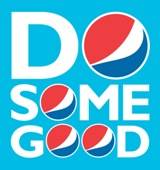 Over the past couple of years or so there has been a steady rise in the phenomena of competitive voting contests for not for profit organizations to receive grants for projects or operations. These contests are run by large corporations as well as not for profit groups. Examples of corporate contests take different shapes such as Pepsi's with the Pepsi Refresh Project which gives grants ranging from $5k to $50k based on competitive community voting toChase Community Giving which touts donations over $600 million dollars through Facebook contests. The National Trust for Historic Preservation has similarly put contests into place by granting to various historic restoration projects based on the number of votes they receive online.
Over the past couple of years or so there has been a steady rise in the phenomena of competitive voting contests for not for profit organizations to receive grants for projects or operations. These contests are run by large corporations as well as not for profit groups. Examples of corporate contests take different shapes such as Pepsi's with the Pepsi Refresh Project which gives grants ranging from $5k to $50k based on competitive community voting toChase Community Giving which touts donations over $600 million dollars through Facebook contests. The National Trust for Historic Preservation has similarly put contests into place by granting to various historic restoration projects based on the number of votes they receive online.
Whether these contests sit well with critic's ethical concerns or not, the volume of web traffic generated for the recipients, the donor organizations, and the organizations who compete but do not win is remarkable. According to Pepsi, the most recent contest in the fall of 2011 garnered more than half a million distinct registrations with over 3.5 million votes counted on the Pepsi site alone. If you aggregate this number with all of the site visits, social network hits, and emails then you have a truly noteworthy phenomena.
Why are people so invigorated by these contests? There are less time intensive ways to earn money in aggregate. One can point to the idea that the contest is a game and the competition itself is what people are engaging in more than the philanthropic cause. It could also be argued that the community effort of building a team to go online and vote for the cause for multiple days has an intrinsic value as well and that by the simple act of building this team you are building and drawing constituents deeper into the arts community.
As these online contest continue even more organizations are starting to do them. The Humane Society recently used a online photo contest to raise hundreds of thousands of dollars, the Case Foundation has been running a voter based contest for years, and American Express has also run contests in the past.
The following are some tips that have been gleaned from articles and criticism of various contests mentioned previously:
1) Make sure that the contest aligns with your mission. By diverting resources for a potential pie in the sky pot of money you can detract from your organization's true work.
2) Ask what your organization can gain from competing for these pots of money? Set forward goals of community building and identify volunteers to assist with these aims.
3) If you are going to market this to your patrons identify your budget for staff time and delegate a reasonably proportional amount of money to pursue getting the word out.
4) Don't start mid-steam. Almost all winners of these contests have strong starts and once you are behind in the voting it is hard to keep up. If you see a contest in progress that you would have liked to take part in simply put it on your calendar for an effort next year as your opportunity may all ready have passed.
Peer to Peer Fundraising in the Digital Age
Back in the day, peer-to-peer fundraising was done with phone calls, letter-writing campaigns, and in-person visits. Now we have a whole new universe of not only digital communication, but digital relationships. Recently, I came across a cool infographic from Blackbaud that illustrated the power of harnessing online social networks to raise money for charity. It got me thinking- what are organizations doing to take advantage of this?
Peer to Peer Products
Peer to peer fundraising tools offered by Blackbaud (Friends Asking Friends) and Convio (Team Raiser) enable team members and participants to set personal fundraising goals and then go about asking friends and family for donations, the deadline for raising funds usually being an organizational event (primarily races to cure diseases). In fact, according to the Chronicle of Philanthropy, all of the top five P2P Giving organizations in 2010 were health organizations (for the top 25 online giving orgs of 2010 view slide 8 here).
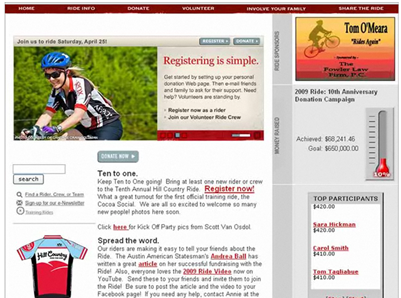
- Convio's Team Raiser

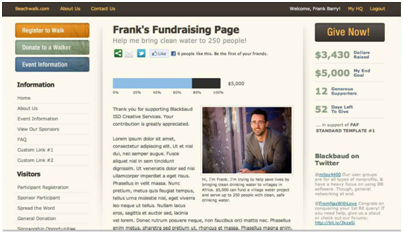
- BlackBaud's Friends Asking Friends- thanks Frank Barry!

If you put on these participant-heavy events, here’s a post about 3 ways to add new event participants. But according to a webinar by Blackbaud on Tuesday, you don’t have to have an event in order to use these tools. Organizations are using them both with ongoing fundraising and with virtual or digital events as well.
Website Tools
Both the Salvation Army and the World Wildlife Federation have cool things that are like the peer to peer tools above, but are designed for ongoing fundraising. The Salvation Army has an “Online Red Kettle”. You can either start your own red kettle, donate to an existing one, or send an eCard to your friends (via email) urging them to support one. If you set up your own, you can have your own fundraising meter, banner ad, or Facebook app.
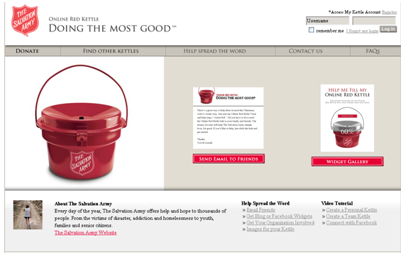
- Online Red Kettle

On the WWF’s site, you can search for or make a super-cute Panda Page (it can be for any animal), then email it to your friends and family. As of right now there weren’t any social media plug-ins on the page.

- World Wildlife Federation Panda Page

Another way to configure your website to encourage peer-to-peer fundraising (also suggested by Frank Barry and Steve MacLaughlin of Blackbaud) is to immediately prompt online donors to share with their social networks when they make a gift, instead of only receiving a regular confirmation page or email. Use Facebook and Twitter plug-ins (like and share buttons, retweets etc) to make it simple for them to share with their networks.
You can also embed those same plug-ins in different areas of your website. Enable somebody to “like” a concert, or retweet a story about your outreach program.
Facebook Causes
Causes has alternately been held up as a model for success and derided for not delivering on its promises. The basic idea is that it allows anyone to create an advocacy group, or “cause”. This cause can then raise funds to donate to a charity. One of the most successful causes is The Nature Conservancy, which has raised over $400,000. An arts success story is Keep the Arts in Public Schools, created by Americans for the Arts, which has raised almost $50,000. People can become members of the cause, donate, tell friends, and “give a minute” by watching and participating in ads that earn money for the cause.
Aaron Hurst of Taproot has been a critic of Facebook Causes since his organization devoted $3,000 of staff time to creating their Cause shortly after Facebook launched the feature. They have received only $60 in return to date. Is Causes a rip-off or a revolution in fundraising? The jury’s still out, but it’s my guess that the different results are due to a combination of knowing how to facilitate peer-to-peer fundraising well, an organization’s existing fan base, and the type of cause. It’s interesting to note that at the Nature Conservancy, social networking was never primarily about raising money- it was “first and foremost a tool for brand and reputation,” said an organizational representative in this 2009 Washington Post article.
Kickstarter
Much has been written about Kickstarter and its cousins, IndieGoGo and RocketHub (among others- check out Pat’s article from last year). And certainly anyone using these tools knows that it’s all about mobilizing your social network. It’s really better suited to specific projects than ongoing fundraising, however. And unless you are able to get your supporters to in turn appeal to their own friends, you are probably going to be asking the same people you always ask anyway.
According to a recent article from NPR, Kickstarter has raised over $50M for creative projects since launching in 2009 and currently attracts $2M in pledges each week for projects.
Check out this Mashable article on other social fundraising alternatives.
The philosophical side
There’s a lot more to this than just raising more money. It’s also about building donors of the future, and increasing not just donations but engagement that will later lead to donations.
On Wednesday, the Case Foundation hosted the Millennial Donors Summit to talk about millennials’ approach to charitable giving. A lot of the points that were made apply not only to millennials, but also to peer-to-peer and social media fundraising. The following is excerpted from Katya’s Non-Profit Marketing Blog:
- It’s not about telling millennials to support you; it’s about creating a vested interest in what you are doing with joint ownership. Let millennials manage your community, design your logo or otherwise be an active partner in what you seek to accomplish.
- At some point, you have to build an army. You can only sell something yourself so many times—you need your community doing it for you, performing the heavy lifting. So give them ownership.
- To be trusted on the web, be an individual, not an organization.
- Look for the small yes.
Something that Frank and Steve mentioned in their webinar this week is that it’s more important to tell a compelling story than it is to make the ask when using social media to fundraise. They gave examples of YouTube videos where the ask was a subtitle. The story is what gets people interested.
Also, give them something to do besides donate. Encourage them to like your page, share the link or video, comment, or even answer a question (like at Free Rice) or send mom a card.
Many of these examples are from very large organizations that have teams of people to create these web tools. But these ideas can be applied on a smaller scale. How have you empowered your constituents to raise money and awareness for you? Do you know of arts organizations who are doing it successfully?
Philanthroper: A New Daily Deal Site for Non-Profit Donations
 A new daily deal site launched this past month, but this site doesn’t offer a deal for a spa trip or half off dinner at some posh restaurant. New site Philanthroper offers a non-profit story a day, a daily solicitation for a non-profit doing some good, and asks visitors to give just one dollar. Launched by Mark Wilson, reporter for Gizmodo and Esquire, Philanthroper aims to make donating a daily habit for the internet culture.
The idea behind Philanthroper is very similar to dynamite daily deal sites like Groupon and Living Social. Each non-profit gets front-page realty on the site, but just for 24 hours. Instead of a daily discount, Philanthroper shares the stories of non-profits, from local to global, and gives visitors the opportunity to donate a dollar. When the 24 hours come to an end, a new non-profit goes up and the previous day’s organization receives their funds within about a week.
A new daily deal site launched this past month, but this site doesn’t offer a deal for a spa trip or half off dinner at some posh restaurant. New site Philanthroper offers a non-profit story a day, a daily solicitation for a non-profit doing some good, and asks visitors to give just one dollar. Launched by Mark Wilson, reporter for Gizmodo and Esquire, Philanthroper aims to make donating a daily habit for the internet culture.
The idea behind Philanthroper is very similar to dynamite daily deal sites like Groupon and Living Social. Each non-profit gets front-page realty on the site, but just for 24 hours. Instead of a daily discount, Philanthroper shares the stories of non-profits, from local to global, and gives visitors the opportunity to donate a dollar. When the 24 hours come to an end, a new non-profit goes up and the previous day’s organization receives their funds within about a week.
Why just a dollar? As the site states:
So you can donate another $1 tomorrow. And another the next day. Use Philanthroper daily, and we guarantee, you'll donate more over time than you would have otherwise plus it won't sting your bank account so badly. Use Philanthroper every day and you'll be on the right track to give more, more easily. If you're compelled to make a larger donation, fantastic. We always link their site. So go for it.
Philanthroper restricts the amount you can donate to just that one dollar and limits visitors from donating more than once a day. The idea here isn’t to solicit a major gift, but to create a culture of daily giving. Donating a single dollar can be a pretty tempting request. Personally, I spend more on a cup of coffee or downloading an app that will make my phone sound like an air raid siren.
The financial cut Philanthroper takes from each donation is the biggest thing setting them apart from other crowdfunding sites like Kickstarter and USA Projects. That’s because the amount Philanthroper retains is zero – you read that right, zero. Philanthroper states right out that they will never take a cut of your donation, although the site’s payment service mPayy will take a whopping 1% of each donation – a penny.
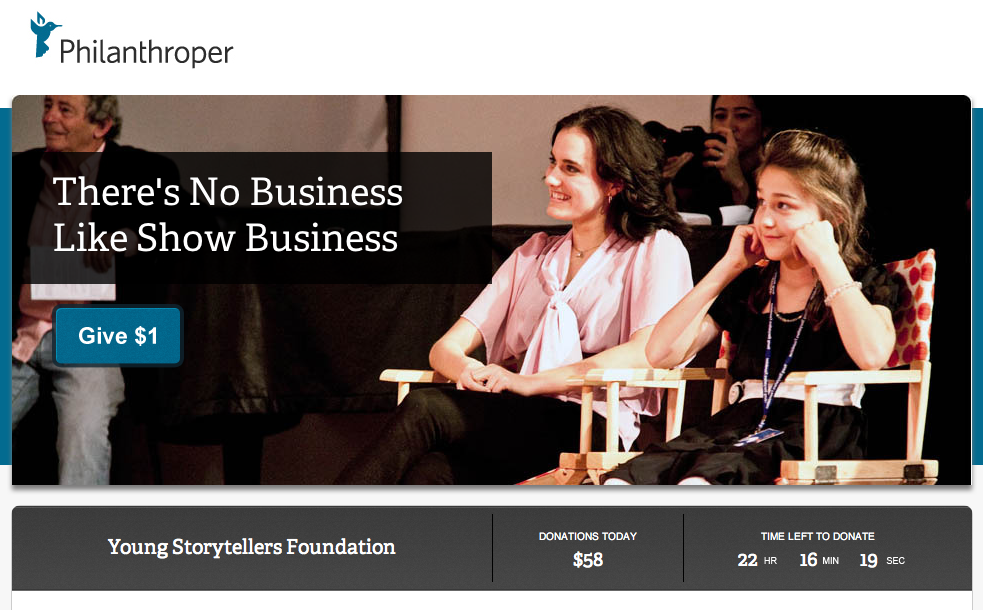
This is how Philanthroper can offer that minimum donation level of $1, whereas other non-profits are often forced to ask for a minimum of around $10 due to the processing rates of current payment services. Support for the site comes from advertising, so as website Arstechnica puts it “…only your eyeballs, and not your charitable gifts, are paying to keep things going.”
How does a non-profit get a daily deal? The site selects only official 501(c)3 organizations, with a special interest in those that bring in less than $1 million per year. The main focus is on those non-profits that are young and growing and could use every single extra dollar. Religious non-profits are not promoted on the site and individuals raising funds will not make the cut. Think you know a non-profit that’s perfect for the site? Philanthroper invites site visitors to suggest tips for non-profits out there worthy of their own daily deal.
Creating a habit of daily giving in our current internet culture is a pretty exciting idea. Philanthroper is taking advantage of the impulsive nature of users of sites like Groupon and Living Social. If the popularity of the site can continue to grow, there is a possibility to make a huge difference for many small non-profits. Visit the main site here and check out what today’s daily cause is that you can throw a dollar towards.
Charitable Donations and the iPhone: What the App, Man?
As the year draws to a close and there is the last, big push for donations by non-profits, who wouldn’t love a one-click, donation button in their app on the iPhone? Well, Apple apparently. There has been some buzz lately over Apple’s policy towards charitable giving on the iPhone.
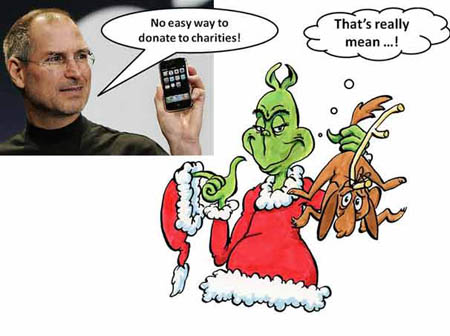
- Photo from PC World

Apple’s policy is that charitable donations cannot take place within an app or through Apple’s app store. If users wish to make a donation, they have to be directed out of the app, through their web browser and may have to contribute additional information. While this may not seem like a huge deal, it does kind of ruin that wonderful impulse that a nice, big red “DONATE NOW” button would have.
So why hate on the big, red button? The answer from Apple has been that they do not want to be responsible for the charitable funds reaching their final destination. But as Jake Shapiro pointed out in a blog post on ars technica:
The excuse that “Apple doesn't want to be held responsible for ensuring that the charitable funds make it to the final destination” is a cop-out. Google Grants has tackled this already, and organizations like TechSoup and Guidestar do a sophisticated job of authenticating nonprofits and charities worldwide.
The real reason may be that charitable donations are just of no interest to Apple. Apple receives 30 cents for every dollar spent in their app store and with a charitable donation, would only be able to claim a processing fee.
While companies like Google and Microsoft have been quick to point out that these problems do not exist with their mobile software, I don’t think this is about finding the one mobile software that perfectly serves the non-profit community. This current stink with Apple more clearly shows the importance of not putting all your eggs in one basket when it comes to developing an organization’s mobile strategy. If you want to voice your displeasure with Apple's policy, an online petition has been started over at care2 and it will be very interesting to see if and how Apple responds.
USA Projects: A New Crowdfunding Platform for the Arts
 Created in 2005 as a grant-making and arts advocacy group based, United States Artists (USA) acts as an avenue for individual artists to find private funding for themselves and their projects. Earlier this month, they entered into the foray of crowdfunding platforms with the launch of the USA Projects, a fund-raising engine that is specifically focused on funding individual artists and their projects through grassroots micro-donations.
Created in 2005 as a grant-making and arts advocacy group based, United States Artists (USA) acts as an avenue for individual artists to find private funding for themselves and their projects. Earlier this month, they entered into the foray of crowdfunding platforms with the launch of the USA Projects, a fund-raising engine that is specifically focused on funding individual artists and their projects through grassroots micro-donations.
Part social network, part fund-raising vehicle, the USA Projects site combines many aspects of other popular crowdfunding sites like Kickstarter, RocketHub, and IndieGoGo. While still in beta testing, the site has already garnered some major attention according to The New York Times:
In testing, the Web site attracted roughly 36,000 unique visitors and raised a total of $210,000, with an average of $120 from each of 1,500 small donors, Ms. DeShaw said.
Not bad at all for a recently launched crowdfunding platform for the arts. Still, there are some major differences between USA projects and the other crowdfunding sites out there. Here’s a look at some of the similarities and differences between USA Projects and its peers:
Similarities
- It’s all or nothing, baby – Like Kickstarter and Rockethub, USA Projects adheres to the “all or nothing policy” wherein projects must meet 100% of their stated fundraising goal, or the funds are returned to their respected donors. Some people have seen this as a great motivator for their projects, while others claim it is a waste of time. This isn’t true of every platform though, IndieGoGo allows people to keep all funds contributed to their projects, even if the final fund-raising goal has not been met.
- The final countdown – As is common on crowdfunding sites, artists on USA Projects have three months in which to raise the money for their projects.
- Getting friendly – Most of the platforms out there have a social media element to them, and the USA Projects site is no exception. Users on the site can create profiles, follow artists and funders, send messages, leave comments, and view recent activity on the projects they have funded or have an interest in. This creates a more personalized experience as well as a stronger connection to the projects and the artists.
- Incentivizin’ – Crowdfunding sites mirror traditional donor campaigns in that different donation levels come with various perks and rewards. Since the perks and rewards are determined by the artists, the endless possibilities are limited only by the artists’ capacity to deliver. Rewards might range from a personal note from the artist to prints or video downloads of the resulting artwork, from private studio visits to the chance to sing back-up on the artist’s CD, etc.
Differences
- At what cost? - In order to meet the bottom line, sites like Kickstarter and RocketHub will charge a percentage of the final funds and for the credit card processing fees. These fees can amount from 5-8% of a project’s total funds raised. Since United States Artists is a not-for-profit organization, there is no fee attached to the projects.
[Correction: According to an FAQ on the USA Projects Web site: "81% of every dollar pledged goes directly to the artist’s project, and 19% supports USA’s programs for artists and the site’s administration." So with this information, it appears that the percentage of funds received by US Artists is two or three times the percentage received by other crowdfunding sites. -- Hat tip to Justin Kazmark.]
- Who gets to play in the sandbox? – Now we hit the major difference between USA crowdfunding and the other platforms out there: not just any artist can add a project to the site. In order to appear on USA Projects, the artist in charge must have received a previous grant or award from a USA Project Partner or recognized organization. Visit the main website here to view all of the recognized organizations and their award/grant programs.
This requirement for artists to have been granted a USA grant, or equivalent from a partner organization, in the past in order to pilot a project raises some interesting questions about this model of crowdfunding:
- Is the policy too exclusive? Requiring grants or awards in order to even start a project excludes a large number of artists right off the bat. And while there are a considerable number of organizations partnering with USA, they do not cover the full spectrum of creative professionals in the United States.
- Does the grant/award requirement go against the spirit of crowdfunding? One of the exciting aspects of crowdfunding is that virtually anyone can start a project and find the funders to make it happen. So what happens to all the first timers? The energetic artists with a great idea and the will to make it happen, but lacking the professional background to make it onto the site? It can be argued that much of the success individuals have had on sites like Kickstarter can be attributed to the strength of the idea behind the project, not necessarily their past accomplishments.
- Will having “approved” artists act as an incentive for people to donate larger amounts? There is definitely a reassurance when donating to an artist who has had some previous success and support. But most existing crowdfunding platforms already have the reassurance of returned funds and set time limits, so how big of an impact will having pre-approved artists make? Will USA’s stamp of approval result in more donations or larger donations for these artists?
It will definitely be interesting to see how the USA Projects platform grows over time and if the requirements for projects will stay the same or evolve with that growth. Additionally, how might this model for crowdfunding the arts affect other existing platforms?
















